九年级下册英语第11单元教案word版本
- 格式:pdf
- 大小:248.32 KB
- 文档页数:12
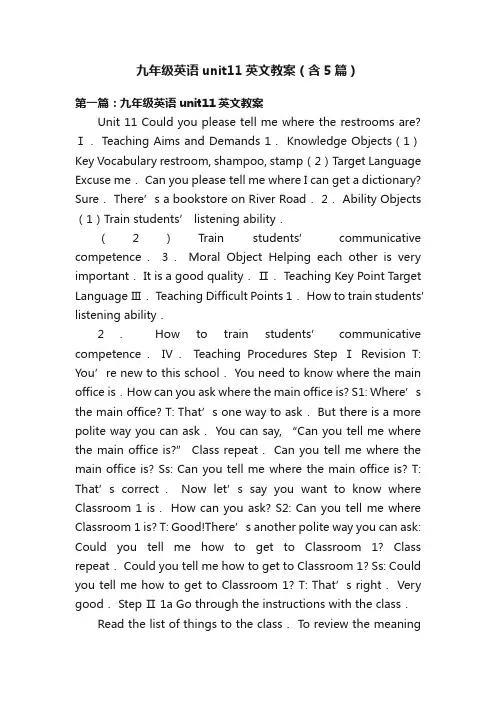
九年级英语unit11英文教案(含5篇)第一篇:九年级英语unit11英文教案Unit 11 Could you please tell me where the restrooms are? Ⅰ. Teaching Aims and Demands 1. Knowledge Objects(1)Key Vocabulary restroom, shampoo, stamp(2)Target Language Excuse me. Can you please tell me where I can get a dictionary? Sure.There’s a bookstore on River Road. 2. Ability Objects (1)Train students’ listening ability.(2)Train students’ communicative competence.3.Moral Object Helping each other is very important. It is a good quality.Ⅱ. Teaching Key Point Target Language Ⅲ. Teaching Difficult Points 1.How to train students’ listening ability.2.How to train students’ communicative competence.Ⅳ.Teaching Procedures Step Ⅰ Revision T: You’re new to this school. You need to know where the main office is.How can you ask where the main office is? S1: Where’s the main office? T: That’s one way to ask. But there is a more polite way you can ask.You can say, “Can you tell me where the main o ffice is?” Class repeat. Can you tell me where the main office is? Ss: Can you tell me where the main office is? T: That’s correct.Now let’s say you want to know where Classroom 1 is. How can you ask? S2: Can you tell me where Classroom 1 is? T: Good!Ther e’s another polite way you can ask: Could you tell me how to get to Classroom 1? Class repeat. Could you tell me how to get to Classroom 1? Ss: Could you tell me how to get to Classroom 1? T: That’s right. Very good.Step Ⅱ 1a Go through the instructions w ith the class.Read the list of things to the class. To review the meaningof each item on the list, invite different students to say each phrase in their own words.Point to the lettered parts of the picture one by one. Ask a student: What kind of place is this? What do they sell there? Do we have one in our community? What is the name of the one in our community? Point out the sample answer.Say, The letter c is in front of the words buy shampoo because you could buy shampoo in a department store.There may be more than one correct answer for some blanks.While students are working, move around the room offering help as necessary.Step Ⅲ 1b Read the instructions to students. Point out the two conversations that are shown in the picture. As you listen, fill in the blanks with words you hear in the recording. Play the recording the first time.Students only listen.Play the recording a second time.This time ask them to fill in the blanks with the words you hear. Check the answers with the whole class.Step Ⅳ 1c Read the instructions to the class.Point out the list of things people need and the pictures of the places in activity 1a.Say.Look at activity la.Have a conversation with a partner. Ask your parter politely where you can do theseThe First Period thi ng and then answer your partner’s questions.As students work, listen to some pairs in order to check the progress and help with pronunciation as needed.After students have had a chance to practise several exchanges, ask some pairs to come to the front of the classroom and act out their conversations.Step Ⅴ Homework Review the target language.Ⅰ. Teaching Aims and Demands 1. Knowledge Objects(1)Key Vocabulary escalator, furniture, exchange money, elevator(2)Target Language Excuse me.Do you know where I can exchange money? Sure.There’s a bank on the second floor. Take the escalator to the second floor and turn right. The bank is next to the bookstore.2.Ability Objects(1)Train students’ listening ability.(2)Train students’ communicative competence. 3. Moral Objects If someone asks you how to get to the place he wants to go to, you should tell him the way correctly.Ⅱ.Teaching Key Points 1.Key Vocabulary exchange money 2. Target Language Excuse me. Do you know where I can exchange money? Sure.There’s a bank on the second floor.3.Structures Do you know where I can buy shampoo? Could you tell me how to get to the post office? Can you please tell me where I can get a dictionary? Ⅲ. T eaching Difficult Points 1. Indirect questions.2.How to improve studen ts’ listening ability.Ⅳ.Teaching Procedures Step Ⅰ Revision Check homework.Step Ⅱ 2a Read the instructions and point to the list of directions.Get students to name the items in the picture such as escalator, elevator, shoe store, and so on.Play the recording. Students only listen.Tell them that the picture may help them understand what they are hearing.Play the recording again. This time ask students to write a number next to four of the directions.Check the answers with the whole class.Step Ⅲ 2b Point tothe picture. Say, now you will hear the recording again. This time show where the boy went as he followed the directions to the drug store. Draw a line on the picture in your book.Play the recording again and ask students to draw the line on their own. Check the answer with the class.Step Ⅳ 2c Ask a pair of students to read the sample conversation aloud to the class.Read the instructions aloud.Say.Make conversations using information about the places in the picture with your partners.As students work, move around the classroom checking the progress of the pairs and offering help as needed.The Second Period Ask one or two pairs to say their conversations to the class. Ask the rest of the class to look at the picture as they listen.Step Ⅴ Homework Ask the students to write three sentences with the starters of the structures.The Third Period Ⅰ.Teaching Aims and Demands 1.Knowledge Objects(1)Key Vocabulary hang out, fresh, advantage, disadvantage, block(2)Target Language Go out the front door and take a right. Walk about three blocks. Go past the park, and turn left onto Oak Street.3.Moral Objects Anything has both advantages and disadvantages.We should treat everything correctly.Ⅱ.Teaching Key Point Train students’ listening, speaking, reading and writing ability.Ⅲ.Teaching Difficult Points How to improve students’ integrating skills.Ⅳ.Teaching Procedures Step Ⅰ Revision T: Yesterday we learned the structures.Do you know where…? Could you tell me how to get to…? Can you ple ase tell me where…? Now who can make sentencesby using the structures? Step Ⅱ 3a Read the instructions. Point out the blank lines under the words Advantages and Disadvantages below the interview.You will write your answers in these blanks.Read the first two sentences at the top of the article.Explain that the interviewer will talk to several teenagers.Get students to read the interview on their own quickly.When they have finished, ask if there are any words or sentences they don’t understand. If there are, explain them.Ask students to read the interview again and write the advantages and disadvantages.Check the answers with the whole class.Step Ⅲ 3b Read the instructions. Point out the conversation in the box and invite two students to read it to the class.Point out the list of advantages and disadvantages in Activity 3a. Say, You can use these items and any other items you can think of as you talk about places you usually hang out.Ask students to work in groups of four or five. As they work, move around the classroom helping the groups as necessary.Make sure they talk about both advantages and disadvantages.Ask several groups to act out part of their conversation to the class.Step Ⅳ 4 Read the instructions to the class. Get students to look back at the picture and activities on the first page of this unit.Point out the sample language in the box. Invite a student to read it to the class.Ask students to say the names of some stores and other places in the community and write them on the board. Say, Each group can choose three of these places to write about, or you canchoose another place you know of Write careful directions from the school to each place, but do not say the name of the place. You can use the words this place instead. In order to help students work, draw a simple map showing the school and several nearby streets.When the groups are ready, they read their directions to the class and the other students guess the name of the place they are talking about.Step Ⅴ Homework 1. Ask students to choose two places in the community and write careful directions from the school to each place.2. Finish off the exercises on pages 46~47 of the workbook.Ⅰ. Teaching Aims and Demands 1. Knowledge Objects(1)Key Vocabulary fascinating, convenient, safe, restroom, inexpensive(2)Target Language Can you tell me where there’s a good place to eat? Of course. What kind of food do you like? 2.Ability Objects(1)Train students’ writing and speaking ability.(2)Train students’ ability to understand the target language in spoken conversation.(3)Train students’ ability to use the target language.Ⅱ. Teaching Key Points 1. Key Vocabulary convenient, safe, restroom inexpensive 2.Target Language Can you tell me where there’s a good place to eat? Of course. What kind of food do you like? Ⅲ. Teaching Difficult Points 1.How to improve students’ writing and speaking ability.2.How to use the target language.Ⅳ.Teaching Procedures Step Ⅰ Revision Check homework.Step Ⅱ 1a Go through the instructions with the class.Read the words in the box to the class and ask if there are any of these words that students don’t understand. If so, helpstudents to explain the meaning of the word.Then read the instructions again and point out the sample answer.Get a student to read the sample answer to the class. Point out that students can also write other words after the word clean. Ask students to write words from the box in the blanks on their own.Help students if needed.Correct the answers by having students read what qualities he or she listed.Step Ⅲ 1b Read the instructions to the class.Point out the example in the box.Invite two students to read it to the class.Now work with a partner.Look at the words in the box and use them to talk about places in your own city.As students talk, move around the classroom checking their work. Offer language support as needed.Invite several pairs of students to say their conversations to the class.Step Ⅳ 2a Point to the picture and ask students to tell what is happening. If necessary, explain that the scene shows a family on vacation.They are asking the man for information about various things to do in Sunville.Go through the instructions and point to the chart.Play the recording. Students only listen the first time.Play the recording again. Ask students to write the places people ask about.Check the answers with the whole class.Step Ⅴ 2b Read the instructions and point to the chart. You will hear the same recording again.This time listen carefully to the answers the cleck gives. Write the answers in the blanks alone.The Fourth Period Point out the sample answer.Play the recording again.Ask students to write their answers in the blanks. Check the answers.Step Ⅵ 2c Point to the sample conversation. Invite two students to read it to theclass. Read the instructions. Role play the conversations you hear on the tape.Get students to work in pairs.Move around the room checking the progress of the pairs and offering help as needed.Ask one or two pairs to say their conversations to the class.Step ⅦHomework Talk about some places using the words in la, then write down the conversations.Ⅰ. Teaching Aims and Demands 1. Knowledge Objects(1)Key Vocabulary water slide, clown, dress up, have fun(2)Practise reading an article.(3)Practise writing something using the target language.2.Ability Objects(1)Train students’ reading ability.(2)Train students’ writing ability.Ⅱ. Teaching Key Point Practise reading and writing using the target language.Ⅲ. Teaching Difficult Point How to write a guide to a place.Ⅳ.Teaching Procedures Step I Revision Review the target language presented in this unit. Check homework. Step Ⅱ 3a Invite a student to read the article aloud to the class. Correct any pronunciation errors to make sure the student is providing a good model for the rest of the class.Ask students to read the article again and complete the chart. Get students to do the work on their own or in pairs. As they work, move around the classroom and offer help as necessary. Check the answers. Step m 3b Read the instructions to the class. Point to the first two sentences and ask a student to read these sentences to the class.Look back at Activities 2a and 2b. Use this information to help you complete the guide to Sunville. Ask the students to complete the brochure on their own. As they work, walk around the classroom offering help and answering questions as needed.Invite a student to read the completed article to the class.Step Ⅳ 3c Read the instructions to the class.Ask students to say the names of some of the places they might write about. Write a list of these places on the board for students to use as they write their guides.Ask students to work on their own. Tell them that they can use what they wrote for activity 3b as a guide. They can write the guide for all tourists, teenagers, families, or people on a budget. As they work, move around the room offering help as needed.Correct the students’ work. Ask some students to read their guides and correct them.Step Ⅴ Part 4 G o through the instructions with the class.Get students to look back at the guides they wrote in Activity 3c.Ask students to work in groups of four or five students. Let different students play the role of the booth worker and the different tourists.Make sure every student has a chance to participate.Ask one or two groups to say one of their conversations to the class.The Fifth Period Step Ⅵ Homework 1. Read the article in 3a again. 2. Write a guide to our city.Ⅰ. Teaching Aims and Demands 1. Knowledge Objects(1)Fill in blanks and make sentences using beautiful, safe, delicious, convenient, fascinating.(2)Write some questions using the target language.2.Ability Objects Train students’ writing ability.Ⅱ.Teaching Key Points 1.Fill in blanks and make sentences.2.Write questions using the target language.Ⅲ. Teaching Difficult Point Make sentences using “beautiful, safe, delicious, convenient,fascinating”.Ⅳ.Teaching Procedures Step Ⅰ Revision Check homework. Ask a few students to read the article in 3a. Then ask a few students to read their guides.Step Ⅱ Part 1 Look at the words in the box. Ask a student to read them. Make sure the students understand the meaning of the words. You are to fill in the blanks with the words. In some cases, students may need to use another form of the word, for example adjusting for tense or subject/ verb agreement.Ask students to fill in the blanks on their own. Check the answers.Step ⅢPart 2 Go through the instructions with the class.Look at the example with the students.Ask students what the answer would be.Ask a student to read the question and answer it.Excuse me, could you tell me where the bank is, please? The bank is across the street from the shopping malt. Get students to complete the work in pairs.Check the answers.Ask a few students to read their questions.Step Ⅳ Just for Fun!Ask all the students to read the conversation.Ask: What is funny about this cartoon? Help students to explain. A Martian is a person from the planet Mars.There is no such thing as Martian food on Earth, and the clerk looks silly because he is trying to think of where there is a Martian restaurant.Invite some pairs of students to present this conversation to the rest of the class.Step Ⅴ Summary and Homework In this class, we’ve done much writing practice using the key vocabulary words and the target language presented in this unit. After class, please finish the questions in 2 in your exercise books.Then finish the exercises on pages 47~48 of the workbook as well.The Sixth PeriodThe Seventh PeriodⅠ Teaching Aims and Demands 1. Knowledge Objects(1)Key Vocabulary image, adventure, jealousy, hero, crime, journey, brave, no longer, show interest in, take it easy, become interested in, plain looks(2)Text: Grown-ups like cartoons, too. 2. Ability Objects(1)Fast-reading to get a general idea of the text.(2)Careful-reading to get the detailed information in the text.(3)Learn the words and phrases from the context.Ⅱ. Teaching Key Points 1. Key vocabulary.2.Train students’ reading a nd writing skills.Ⅲ.Teaching Difficult Point Train students’ reading and writing skills.Ⅳ. Teaching Procedures Step I Key Vocabulary Say the words and have students repeat them again and again until they can pronounce them fluently and accurately. Step Ⅱ Part 1 Read the title Grown-ups like cartoons, too.To the class. Ask, what do you think the article is about? Look at the picture.Ask students to describe what is happening in the picture. Ask students to answer the five questions.But don’t look at the reading text.Instead, they use their background knowledge to try to answer the questions. As students work, walk around, looking at their progress.When most students finish the task, ask students to answer the questions with a parter.Elicit answers from the students. Ask if other students have the same or different answers. Do not give the correct answers to the students at this point. Wait until students have finished the reading and let them revise their answers accordingly. StepⅢ Part 2 Read the te xt quickly, then summarize each paragraph in your own words. As the students are doing this, move around the classroom to make sure they can do the task in English. Ask five students to report their answers.Draw students’ attention to the instructions.Ask students to complete the task individually or in pairs.As they work, walk around the classroom to make sure students discuss their reasons in English. Have students report their answers.Encourage students to use complete sentences.Step Ⅳ Part 3 Point to the story. Look at the words indicated in bold.Ask different students to guess the meaning.Don’t give them the correct answers. Ask students to read the article once. Say, pay attention to the bold words and expressions. And note any other words or sentences, you don’t understand. Read in context, guessing their meanings from the other words around them. Ask students to read the article again for comprehension.Read the instructions with the students and have them look at the example.Then ask students to match the correct meanings with the correct words and expressions. Allow them one or two minutes to do this.Check the answers: Get students to make sentences with the words and expressions. Remind them to look at the article again for extra help.Answers to this activity will vary.Then ask a students to write his/her answers on the blackboard.Help correct any mistakes.Step Ⅴ Part 4 Read the instructions to the class. Elicit the first answer from the students from memory.Make sure that they understand what they need to do.Ask students to do the activity on their own or in pairs. Asthey work, walk around the classroom offering help students may need. Check the answers.Step Ⅵ Part 5 Read the task with the students.Ask students to do the activity in small groups. Try to put creative and artistic students in each group. Check the answers and have students show or act out their cartoons for the class. Optional activityAs an optional in-class or homework activity, remind students to find some cartoons and cut out the speech bubbles.Students can then write their own English stories in the speech bubbles.Step Ⅶ Homework 1.Read the story in 2 again for further comprehension.2.Revise the target language in this unit.第二篇:九年级英语unit 15教案雨龙中学高效课堂(二次备课)导学案课题:Unit 15 We’re trying to save the manatees!备课组:英语主备教师:杨翠芳授课时间:3.8—3.12授课班级:82,83,84备课组长审核签字:【预习导学——不看不讲】一、明确目标:1.学会区分并正确使用“一般现在时,现在进行时,现在完成时,to + 动词原形,被动语态”;2.阅读3a与3b,并按要求完成课后练习;3.掌握课文中出现的重点词组;4.保护动物,人人有责;二、自主学习:1.翻译GF部分,并区分相应语法和时态;2.翻译词组:(1)反对做某事;(2)适合;(3)对…感到吃惊;(4)活生生的教科书;(5)为某人提供某物;(6)关心、照顾;(7)同意;(8)不同意;三、检查释疑:各小组中对子相互检查自主学习部分,并说说不同答案的理由;【合作探究——不议不讲】一、合作学习: 2.Read a letter to the editor in 3b and give your opinion.3.Debate二、探究展示:各小组对子相互检查合作学习部分的答案,对疑问点提出自己的意见;【导学测评——不练不讲】一、导学测评(一)基础题——初显身手同步解析与测评:单项选择4,5, 8, 9 ;(二)能力题——挑战自我译一译:1.我不同意你的观点,我认为动物园是动物生活的好地方。
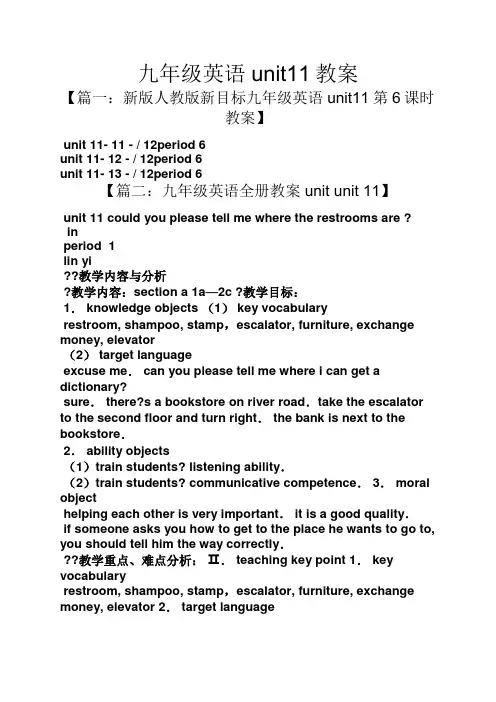
九年级英语unit11教案【篇一:新版人教版新目标九年级英语unit11第6课时教案】unit 11- 11 - / 12period 6unit 11- 12 - / 12period 6unit 11- 13 - / 12period 6【篇二:九年级英语全册教案unit unit 11】unit 11 could you please tell me where the restrooms are ?inperiod 1lin yi??教学内容与分析?教学内容:section a 1a—2c ?教学目标:1. knowledge objects (1) key vocabularyrestroom, shampoo, stamp,escalator, furniture, exchange money, elevator(2) target languageexcuse me. can you please tell me where i can get a dictionary?sure. there?s a bookstore on river road.take the escalator to the second floor and turn right. the bank is next to the bookstore.2. ability objects(1)train students? listening ability.(2)train students? communicative competence. 3. moral objecthelping each other is very important. it is a good quality.if someone asks you how to get to the place he wants to go to, you should tell him the way correctly.??教学重点、难点分析:Ⅱ. teaching key point 1. key vocabularyrestroom, shampoo, stamp,escalator, furniture, exchange money, elevator 2. target languageexcuse me. do you know where i can exchange money? sure. there?s a bank on the second floor. 3. structuresexcuse me. can you please tell me where i can get a dictionary? do you know where i can buy shampoo? could you tell me how to get to the post office? sure. there?s a bookstore on river road.take the escalator to the second floor and turn right. the bank is next to the bookstore.Ⅲ. teaching difficult points1. how to train students? listening ability.2. how to train students? communicativecompetence. 3. to learn to use indirect questions and tell about places??learning strategies: listen for specific information, cooperating ?? 课前准备教学课件和录音机 ?? 教师设计教学步骤建议和说明step1 warm-up by learning new words 大脑风暴,打开学生have a try. where can we do these things? 思维。
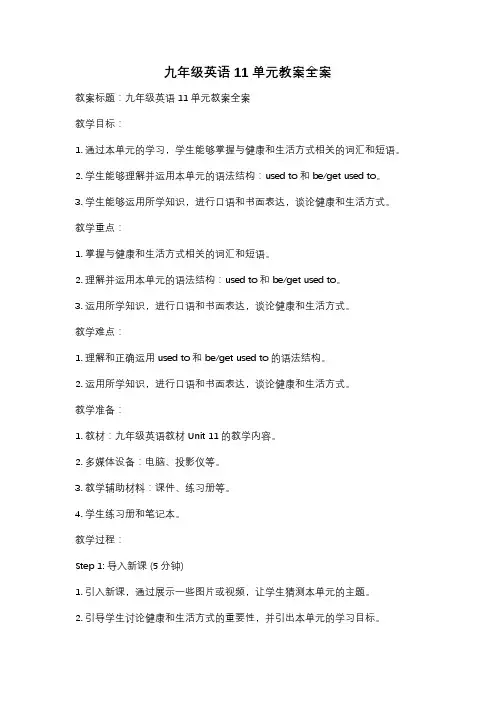
九年级英语11单元教案全案教案标题:九年级英语11单元教案全案教学目标:1. 通过本单元的学习,学生能够掌握与健康和生活方式相关的词汇和短语。
2. 学生能够理解并运用本单元的语法结构:used to和be/get used to。
3. 学生能够运用所学知识,进行口语和书面表达,谈论健康和生活方式。
教学重点:1. 掌握与健康和生活方式相关的词汇和短语。
2. 理解并运用本单元的语法结构:used to和be/get used to。
3. 运用所学知识,进行口语和书面表达,谈论健康和生活方式。
教学难点:1. 理解和正确运用used to和be/get used to的语法结构。
2. 运用所学知识,进行口语和书面表达,谈论健康和生活方式。
教学准备:1. 教材:九年级英语教材Unit 11的教学内容。
2. 多媒体设备:电脑、投影仪等。
3. 教学辅助材料:课件、练习册等。
4. 学生练习册和笔记本。
教学过程:Step 1: 导入新课 (5分钟)1. 引入新课,通过展示一些图片或视频,让学生猜测本单元的主题。
2. 引导学生讨论健康和生活方式的重要性,并引出本单元的学习目标。
Step 2: 词汇和短语学习 (15分钟)1. 呈现本单元的主要词汇和短语,如healthy lifestyle, junk food, exercise等,并帮助学生掌握其发音和意义。
2. 进行词汇和短语的练习,如词义配对、填空等。
3. 引导学生运用所学词汇和短语进行口语练习,如对话、描述等。
Step 3: 语法学习 (15分钟)1. 介绍used to和be/get used to的用法和区别。
2. 通过例句和练习,帮助学生理解和掌握这两个语法结构。
3. 进行语法练习,如填空、改错等。
Step 4: 口语表达练习 (20分钟)1. 分组进行角色扮演,让学生运用所学知识,模拟真实情境,谈论健康和生活方式。
2. 引导学生互相提问和回答,加强口语表达能力。
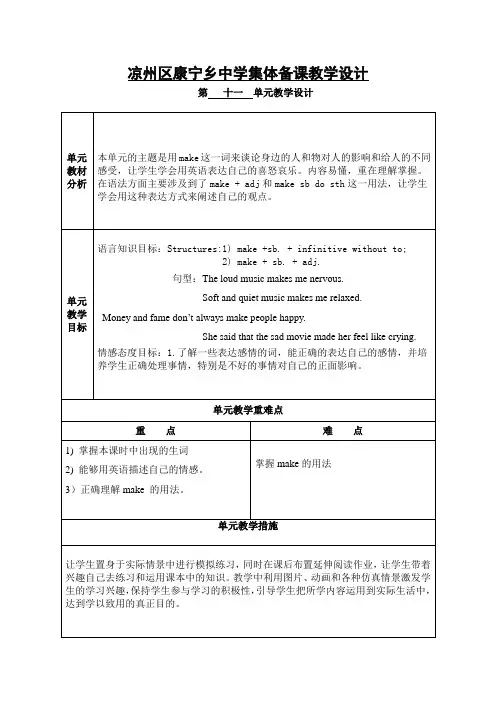
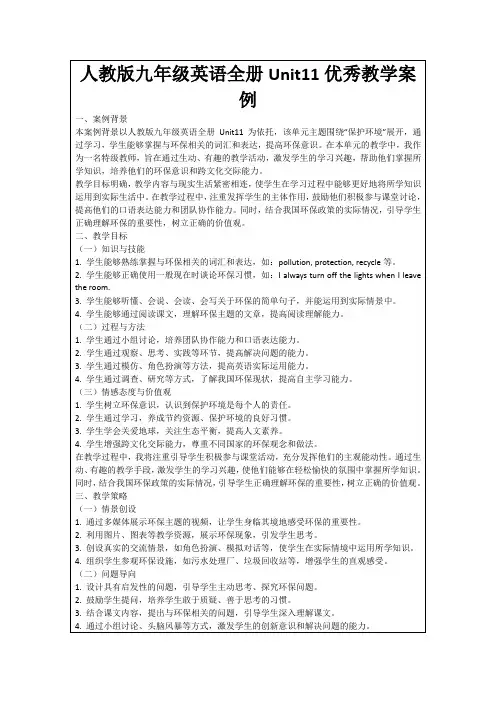
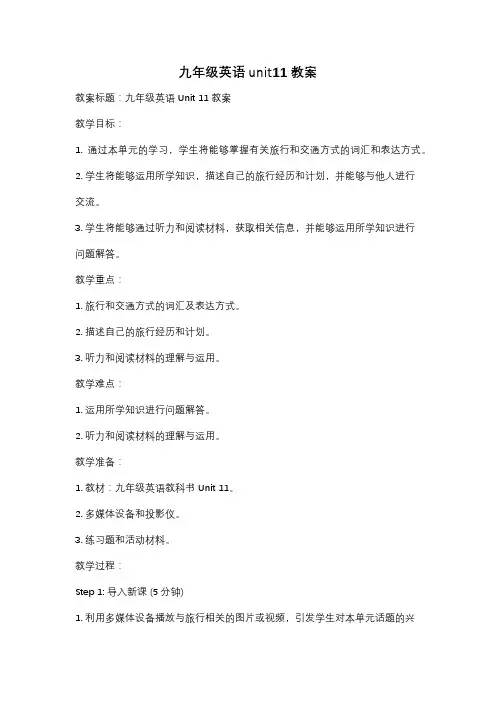
九年级英语unit11教案教案标题:九年级英语 Unit 11 教案教学目标:1. 通过本单元的学习,学生将能够掌握有关旅行和交通方式的词汇和表达方式。
2. 学生将能够运用所学知识,描述自己的旅行经历和计划,并能够与他人进行交流。
3. 学生将能够通过听力和阅读材料,获取相关信息,并能够运用所学知识进行问题解答。
教学重点:1. 旅行和交通方式的词汇及表达方式。
2. 描述自己的旅行经历和计划。
3. 听力和阅读材料的理解与运用。
教学难点:1. 运用所学知识进行问题解答。
2. 听力和阅读材料的理解与运用。
教学准备:1. 教材:九年级英语教科书 Unit 11。
2. 多媒体设备和投影仪。
3. 练习题和活动材料。
教学过程:Step 1: 导入新课 (5分钟)1. 利用多媒体设备播放与旅行相关的图片或视频,引发学生对本单元话题的兴趣。
2. 引导学生分享自己的旅行经历或对旅行的期待,鼓励他们用英语进行表达。
Step 2: 词汇和表达 (15分钟)1. 呈现本单元的重点词汇和表达方式,例如:destination, accommodation, means of transportation, etc.2. 通过图片、示范和实物等方式帮助学生理解和记忆这些词汇和表达方式。
3. 进行词汇练习,例如:词汇填空、情景对话等。
Step 3: 阅读和听力 (20分钟)1. 指导学生阅读本单元的课文,帮助他们理解文章的大意和重要细节。
2. 进行听力训练,例如:听录音并回答问题、听录音填空等。
Step 4: 交流和练习 (15分钟)1. 学生分组进行小组讨论,分享自己的旅行经历或计划,并使用本单元所学的词汇和表达方式进行交流。
2. 进行口语练习,例如:角色扮演、情景对话等。
Step 5: 拓展活动 (10分钟)1. 利用多媒体设备呈现一些与旅行相关的图片或视频,让学生进行描述和讨论。
2. 提供问题,引导学生思考和讨论旅行的利弊、文化交流等相关话题。
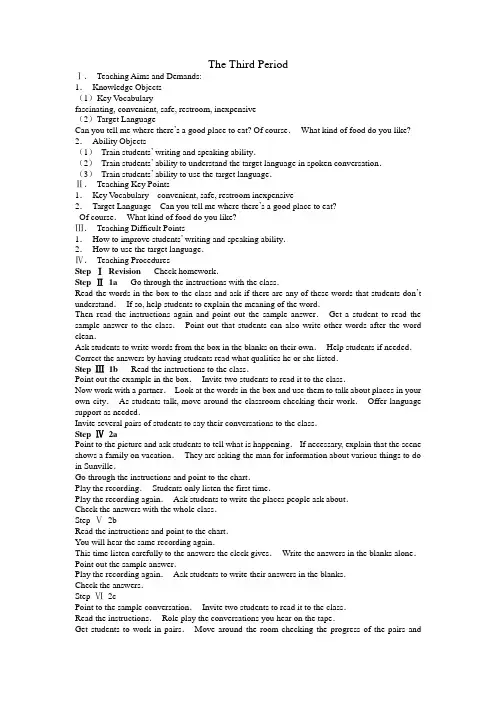
The Third PeriodⅠ.Teaching Aims and Demands:1.Knowledge Objects(1)Key Vocabularyfascinating, convenient, safe, restroom, inexpensive(2)Target LanguageCan you tell me where there’s a good place to eat? Of course.What kind of food do you like? 2.Ability Objects(1)Train students’ writing and speaking ability.(2)Train students’ ability to understand the target language in spoken conversation.(3)Train students’ ability to use the target language.Ⅱ.Teaching Key Points1.Key Vocabulary convenient, safe, restroom inexpensive2.Target Language Can you tell me where there’s a good place to eat?Of course.What kind of food do you like?Ⅲ.Teaching Difficult Points1.How to improve students’ writing and speaking ability.2.How to use the target language.Ⅳ.Teaching ProceduresStep ⅠRevision Check homework.Step Ⅱ1a Go through the instructions with the class.Read the words in the box to the class and ask if there are any of these words that students don’t understand.If so, help students to explain the meaning of the word.Then read the instructions again and point out the sample answer.Get a student to read the sample answer to the class.Point out that students can also write other words after the word clean.Ask students to write words from the box in the blanks on their own.Help students if needed.Correct the answers by having students read what qualities he or she listed.Step Ⅲ1b Read the instructions to the class.Point out the example in the box.Invite two students to read it to the class.Now work with a partner.Look at the words in the box and use them to talk about places in your own city.As students talk, move around the classroom checking their work.Offer language support as needed.Invite several pairs of students to say their conversations to the class.Step Ⅳ2aPoint to the picture and ask students to tell what is happening.If necessary, explain that the scene shows a family on vacation.They are asking the man for information about various things to do in Sunville.Go through the instructions and point to the chart.Play the recording.Students only listen the first time.Play the recording again.Ask students to write the places people ask about.Check the answers with the whole class.Step Ⅴ2bRead the instructions and point to the chart.You will hear the same recording again.This time listen carefully to the answers the cleck gives.Write the answers in the blanks alone.Point out the sample answer.Play the recording again.Ask students to write their answers in the blanks.Check the answers.Step Ⅵ2cPoint to the sample conversation.Invite two students to read it to the class.Read the instructions.Role play the conversations you hear on the tape.Get students to work in pairs.Move around the room checking the progress of the pairs andoffering help as needed.Ask one or two pairs to say their conversations to the class.Step ⅦHomeworkTalk about some places using the words in la, then write down the conversations.。
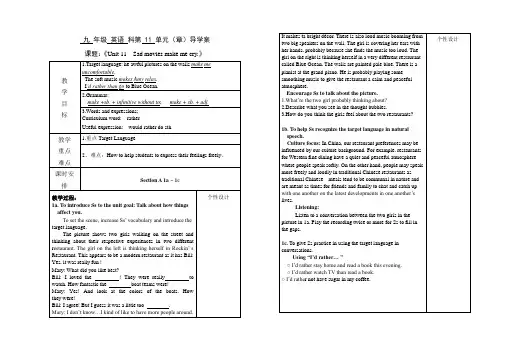
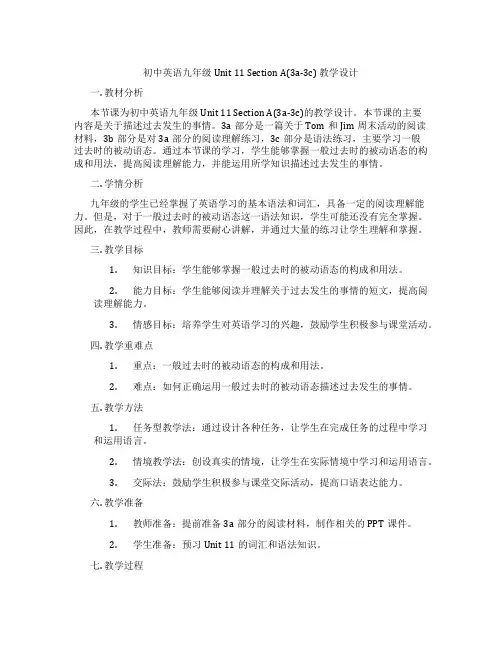
初中英语九年级 Unit 11 Section A(3a-3c) 教学设计一. 教材分析本节课为初中英语九年级Unit 11 Section A(3a-3c)的教学设计。
本节课的主要内容是关于描述过去发生的事情。
3a部分是一篇关于Tom和Jim周末活动的阅读材料,3b部分是对3a部分的阅读理解练习,3c部分是语法练习,主要学习一般过去时的被动语态。
通过本节课的学习,学生能够掌握一般过去时的被动语态的构成和用法,提高阅读理解能力,并能运用所学知识描述过去发生的事情。
二. 学情分析九年级的学生已经掌握了英语学习的基本语法和词汇,具备一定的阅读理解能力。
但是,对于一般过去时的被动语态这一语法知识,学生可能还没有完全掌握。
因此,在教学过程中,教师需要耐心讲解,并通过大量的练习让学生理解和掌握。
三. 教学目标1.知识目标:学生能够掌握一般过去时的被动语态的构成和用法。
2.能力目标:学生能够阅读并理解关于过去发生的事情的短文,提高阅读理解能力。
3.情感目标:培养学生对英语学习的兴趣,鼓励学生积极参与课堂活动。
四. 教学重难点1.重点:一般过去时的被动语态的构成和用法。
2.难点:如何正确运用一般过去时的被动语态描述过去发生的事情。
五. 教学方法1.任务型教学法:通过设计各种任务,让学生在完成任务的过程中学习和运用语言。
2.情境教学法:创设真实的情境,让学生在实际情境中学习和运用语言。
3.交际法:鼓励学生积极参与课堂交际活动,提高口语表达能力。
六. 教学准备1.教师准备:提前准备3a部分的阅读材料,制作相关的PPT课件。
2.学生准备:预习Unit 11的词汇和语法知识。
七. 教学过程1.导入(5分钟)教师通过提问方式引导学生回顾一般过去时的被动语态的构成和用法。
例如:“请大家回忆一下,我们之前学过的一般过去时的被动语态是怎么构成的?它有哪些用法?”2.呈现(10分钟)教师呈现3a部分的阅读材料,让学生独立阅读,并回答相关问题。
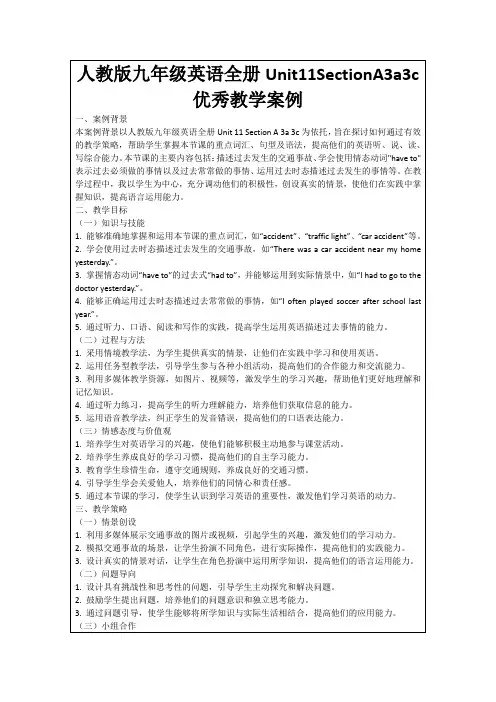
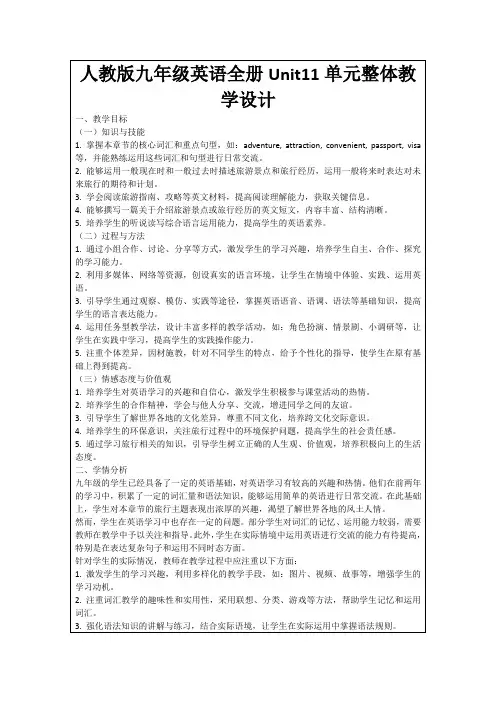
Review of units 11~15The First PeriodⅠ.Teaching Aims and Demands1.Knowledge ObjectsKey vocabulary that students have learned in Units 11~15.2.Ability ObjectsTrain students’ ability to use the target language they have learned freely and creatively.3.Moral ObjectRepetition is the mother of learning.Ⅱ.Teaching Key PointKey vocabularyⅢ.Teaching difficult PointTrain students’ ability to use the target language they have learned freely and creatively.Ⅳ.Teaching MethodPractice methodⅤ.Teaching AidThe blackboardⅥ.Teaching ProceduresStep I RevisionCheck homework.Ask five students to read their sentences one by one using the words in activity 1 in preceding class.Help correct the mistakes made in their sentences.Step Ⅱ1aThis activity reviews some of the vocabulary that students have learned in Go For It Book 5.In this activity, we’ll reviens some of the vocabulary in Units 1~15 by completing a crossword.Now, look at the clues with the headingsDown and Across.Draw students’ attentio n to the crossword.Read the sample answer to the class: I can look out of the window in my apartment.Make sure that they understand what they need to do.Then say, Please read the clues and complete the crossword.Get students to do the crossword in pairs.While they are working, move around the classroom to make sure that all the students know what to do, offering help if necessary.Cheek the answers by asking different students to read out and spell the answers.AnswersDown 1.windows 2.bought 3.is 5.elephant 6.wrong 7.suitcase 8.award 12.made15.scarf 16.jobs 18.rude 19.meet 20.orAcross 1.walls 4.noodles 7.strong 8.are 9.on 10.trash 11.sit 13.had 14.done 17.customer 21.ever 22.fast 23.cheetahStep Ⅲ1bThis activity requires students to creatively use the language they have learned.Go through the instructions with the class.Invite a pair of students to read the sample conversation.S A: This is a place where we can go to see animals.S B: Is it a zoo?S A: Yes, it is.Make sure students understand what they need to do.Ask students to choose four words from Units 11~15 and write a clue for each word.Have students do the activity in pairs.When they work, move around the classroom listening and offering help where necessary.Ask four students to say their clues and have the class guess the words.S1: It is useful and helpful to us and can bring us success in competition.(advantage)S2: This is a person who owns something.(owner)S3: This is a metal container in which food is kept cold.(refrigerator)S4: This is a large sea animal.We also call it sea cow.(manatee)Step ⅣSummaryIn this class, we’ve reviewed some of the vocabulary words in Units 1~15.Step ⅤHomeworkReview the vocabulary words in Units 11~15Step ⅥBlackboard DesignReview of units 11~15The Second PeriodⅠ.Teaching Aims and Demands1.Knowledge Objects(1)Listening practice using the target language.(2)Oral practice using the target language.2.Ability Objects(1)Train students’ listening skill.(2)Train students’ speaking skill.3.Moral ObjectIf you review what you have learned actively, you will make greater progress.Ⅱ.Teaching Key Points1.Listening practice using the target language.2.Oral practice using the target language.Ⅲ.Teaching Difficult PointTrain students’ listening skill.Ⅳ.Teaching Methods1.Listening method to improve students’ listening ability.2.Pairwork to make every student work in class.Ⅴ.Teaching AidA tape recorderⅥ.Teaching ProceduresStep ⅠRevisionDictate some vocabulary words in Units 11~15.guidebook, member, advantage, manatee, environment, greet, bow, wipe, serve, miss, fresh, rude, endangered, useful, strong, tiny, politely, mostly, gradually, speciallyChoose five words.Encourage students to make sentences with them.S1: Everyone has more advantages than disadvantages.S2: Manatees are large sea animals.S3: Let’s go out for some fresh air.S4: He was late for school because he missed the bus.S5: The ant is a tiny insect.Step Ⅱ2aThis activity provides practice in listening for the general idea.focus attention on the four pictures.Say, You are going to listen to four conversations.Match the conversations with the correct pictures.Point to the sample answer.Say, This picture matches the first conversation you will hear.Play the recording for the first time.Students only listen.Play the recording a second time.This time students listen and match the conversations with the correct pictures by writing the numbers in the boxes.Check the answers.Answers(from top to bottom)1,4,2,3TapescriptConversation 1Cbu: Tom, I have some questions about your country, Canada.Tom: Okay.What do you want to know?Cbu: What are you supposed to do when you meet someone for the first time?Tom: You’re supposed to shake hands.Cbu: How about time? For example, when a party is at eight o’clock, do you go at eight o’clock? Torn: No, you can go about fifteen minutes late.Cbu: OK.Is it the same for business meetings?Tom: Oh no.For a business meeting make sure you’re on time.Cbu: Mm.I heard that it’s rude to make sounds when you eat.Is that true?Tom: Yes.it is.You shouldn’t do it.Cbu: One more question.Are you supposed to take a gift when you visit someone?Tom: Yes, it’s polite to take a few flowers.Cbu: Thanks.Now I’m ready.Conversation 2Ben: Excuse me, could you tell me where the doctor’s office is?Sue: Yes, it’s on the second floor, beside the esc alator.Ben: Mm.First I need to buy a book.Is there a book store around here?Sue: Sure.You can find Biblo Books on the fourth floor.Take the elevator.Ben: Oh, I also need to exchange some money.Sue: Yes.There’s a bank on the first floor.It’s right behind you.Ben: Good.I think that’s everything.Oh no.There’s one more place I need to go.Sue: Yes?Ben: Do you know where I can buy some shampoo?Sue: Yes, there’s a drugstore on the third floor.Take the elevator.Ben: Thank you.You’ve been very he lpful.Sue: You’re welcome.Conversation 3Mom: We have to leave in half an hour.Is everything ready for the trip?Xiao Li: I don’t know.Mom: Well, have you packed the travel guidebook?Xiao Li: Yes.I did.Oh! But I forgot the map.Mom: OK.Pack the map.What about the camera?Xiao Li: Yes.I have the camera.Mom: What’s that noise? Have you turned off your radio?Xiao Li: No, I’ll do it now.Mom: And the towels.Have you packed the towels yet?Xiao Li: Yes.I packed the towels.Mom: What about the food? Did you pack the food?Xiao Li: Yes.I’ve packed it already.Morn: Well, I think we’ve almost ready!Conversation 4Henry: Hi, Janet.Would you like to help save the environment?Janet: I don’t know.What can I do?Henry: Well, first, you can start by turning off the lights.Janet: Yes.That’s easy.Sometimes I turn on the lights without thinking.What’s next?Henry: Second, you can ride a bicycle.Don’t take a bus or a taxi if you don’t have to.Janet: That will save money, too.What else?Henry: Thrid, try to recycle paper.Janet: Mm.Newspapers, magazines, mail …we get a lot of paper at home.Good idea.Henry: The fourth idea is turning off the shower When you’re not using it.Janet: You mean, when I have shampoo in my hair?Henry: Yes.Get wet.Turning off the shower.Put in the shampoo in your hair and then turn on the shower and wash it out.Janet: Will that help the environment?Henry: Yes.We have to save water.And fifth, take a bag when you go shopping.Don’t use plastic bags.Janet: OK.My parents do most of the shopping.I’ll tell them.Step Ⅲ2bThis activity requires students to listen for specific information in the dialogues.Look at the four different questions types next to the pictures in Activity 2a.Give students two minutes to go through the list of questions.You are going to listen to the same recordingagain.This time you need to listen for specific information in the dialogues that will help you answer the questions.Point out the sample answers.Play the recording for students to answer the questions.Play the recording a second time or a third time if necessary.Have students do the activity in pairs.When they work, walk around the classroom listing and offering help where necessary.Ask several students to share their answers.AnswersFTFFT53214doctor’s office--second floor;bookstore--fourth floor;bank--first floor; drugstore--third floor√pack the guidebook; ×pack the map;√pack the camera;×Turn off the radio;√pack the towels;√pack the foodStep Ⅳ2cThis activity lets students work in pairs to practise the conversations they have just heard.Go through the instructions with the class, sample conversation in the box.Invite a pair of students to read it to the class.S A: Would you like to help save the environment?S B: I don’t know.What can I do?Write the sample conversation on the blackboard.Now work with a partner.Start by reading the sample conversation in the box with your partner.Then make conversations using information in Activity 2a.Get students to practise their conversations.As they work, walk around the classroom offering help and encouragement.Ask several pairs of students to say their conversations to the class.For example:S A: Would you like to help save the environment?S B: I don’t know.What can I do?S A: You can turn off the shower while you are washing your hair.S B: When I have shampoo in my hair?S A: Yes.Step ⅤSummaryIn this class, we’ve done a lot of listening and oral practice Using the target language.Step ⅥHomeworkAsk students to write three conversations in Activity 2c in their exercise books.Step ⅦBlackboard DesignReview of Units 11~15The Third PeriodⅠ.Teaching Aims and Demands1.Knowledge ObjectsOral practice using the structures Supposed to, It makes me…and Present perfect with already and yet.2.Ability Objects(1)Train students’ speaking skill.(2)Train students’ writing skill.3.Moral ObjectExpress your own opinions freely and correctly.Ⅱ.Teaching Key Points1.Supposed to2.It makes me…3.Present perfect with already and yet.Ⅲ.Teaching Difficult PointTrain students’ speaking and writing skills.Ⅳ.Teaching Methods1.Practice method2.PairworkⅤ.Teaching AidThe blackboardⅥ.Teaching ProceduresStep I RevisionCheck homework.Invite several students to say their conversations to the class.Check any errors and correct them.Step ⅡPart 3This activity provides writing and speaking practice using the target language.Go through the instructions with the class.Look at the sample conversation in the box.Invite a pair of students to read it aloud to the class.A: What are you supposed to do when you meet a new person in the USA?B: You’re supposed to shake hands.A: In China, you’re supposed to…Write the conversation on the blackboard.Look at the list of questions.Get a student to read the questions to the class.Please write your answers to these questions.Ask students to finish the task on their own.The answers may vary.For example:A: What are supposed to do when you meet someone in China?B: You are supposed to bow to the person/say Hi to the person/shake hands with the person.Ask students to fill in their answers, then discuss with a partner.While they are working, move around the classroom listening to different pairs and offering help as needed.Ask several pairs to share their activities.Step ⅢPart 4This activity lets students work in pairs to practice writing and speaking skills.Go through the instructions with the class.Look at the sample conversation in the box.Invite a pair of students to read it aloud to the class as a model.S A: How do you feel when you see the national flag of China?S B: It makes me feel proud.How about you?S A: It makes me proud, too.I think of famous Chinese men and women.Write the conversation on the blackboard.Review the different feelings in different situations students have learned.(happy, angry, sleepy, sad, relaxed, tense, etc)Ask students to give their feelings for each of the five items.Say, Please work in pairs.Make conversations to talk about your feelings in different situations.For each item, students should think of a reason for their answer.As they work, move around the classroom listening and offering help as needed.Ask several pairs of students to say their conversations to the class.Answers will vary.Step ⅣPart 5This activity provides practice to train students’ writing and speaking skills.Look at the instructions.Let a student to read it aloud to the class.Read the sample answer history project to the class.Say, Please make a list of the things you plan to do this month.Ask students to complete the task individually.Point to the sample conversation in the box.Invite a pair of students to read it to the class.S A: I have to do my history project this week.S B: Really? I’ve already done my history project.Write the conversation on the blackboard.Get students to think of things they need to do today.Ask them to say whether or not they have already done each thing.Ask students to write a list of five things to do this month.Please compare your list with your partner’s.Discuss what you have or have not already done.Ask several pairs to share their discussions with the class.Answers will vary.Step ⅤSummaryIn this class, we’ve reviewed the structures Supposed to, It makes me…and Present perfect with already and yet by writing and oral practice.Step ⅥHomeworkAsk students to write two sentences for each structure in their exercise books.Step ⅦBlackboard DesignReview of Units 11~15The Fourth PeriodⅠ.Teaching Aims and Demands1.Knowledge Objects(1)Practise talking about hobbies.(2)Practise asking for information politely.(3)Practise using I think/believe/feel that…and I agree/disagree with you.2.Ability Objects(1)Train students’ speaking ability.(2)Train students’ writing ability.3.Moral ObjectsPractice makes perfect.Ⅱ.Teaching Key Points1.Talk about hobbies.2.Ask for information politely.3.I think/believe/feel that…and I agree/disagree with you.Ⅲ.Teaching Difficult PointsTrain students’ speaking and writing skills.Ⅳ.Teaching methods1.Pairwork2.Practice methodⅤ.Teaching AidThe blackboardⅥ.Teaching ProceduresStep ⅠRevisionCheck homework.Ask students to exchange their homework exercise with a partner.Help correct each other’s mistakes.Then get different students to say their sentences to the class.S1: We’re supposed to do our homework on time.S2: Pop music makes me happy.S3: Have you cleaned your room yet?S4: Yes.I have already cleaned my room.Step ⅡPart 6This activity provides writing and oral practice using the target language.Go through the instructions with the class.Look at the sample conversation in the box.Invite a pair of students to read it to the class.S A: What kind of museums do you like?S B: I like history museums.They’re interesting.S A: Really? I prefer science museums.Write the conversation on the blackboard.Draw students’ attention to the chart.Ask students to read the questions.Please write down your own answers in the first column in the chart.Get students to complete the task individually.Then ask students to interview two classmates about what they like and write their answers in the second and the third columns in the chart.Get students to complete the task in groups if three.As the groups work together, walk around the classroom to make sure all the students know how to fill in the blanks and offer language support as needed.Get different students to report their results like this:S A: What kind of sports do you like?S B: I like football.It is very exciting.S A: Really? I prefer basketball.Answers will vary.Step ⅢPart 7This activity lets students work in pairs to practise writing and speaking skills.Go through the instructions with the class.Look at the sample conversation in the box.Invite a pair of students to read it to the class.S A: Excuse me.Can you help me?S B: Yes, certainly.How can I help you?S A: Can you tell me if there are any good museums in the city?S B: There are many good museums.Do you like art?S A: Yes.I like it very much.Write the conversation on the blackboard.Ask a few students about museums, food, transportation and costs.Then write questions using the four sentences as guides.Please make conversations using the questions.Then ask students to role play conversations with their partners using their questions.Have some students share their answers as dialogues with the class.A sample conversation:S A: Excuse me.Can you help me?S B: Yes, certainly.How can I help you?S A: Could you tell me where I can get some good food?S B: There are a lot of good restaurants.What kind of food do you like?S A: Vegetarian.S B: You can try Green Restaurant.They have delicious salads.Step ⅣPart 8This activity provides writing and oral practice using the target language.Read the instructions aloud to the class.Point to the sample conversation in the box.Invite a pair of students to read it to the class.S A: I think that cats are the most important animal in China because many people have them as pets.S B: I disagree.I feel that pandas are the most important animal because there aren’t very many of them.S A: Yes, but cats are more popular with ordinary people.Write the conversation on the blackboard.Ask students to select an animal and write five reasons why it is the most important animal in China.Let them use the words in the box to discuss their opinions in conversations.As they work, walk around the classroom, checking the progress of the pairs and offering language support as needed.Get several pairs of students to say their conversations to the class.Answers will vary.Step ⅤSummaryIn this class, we’ve practised talking about hobbies and asking for information politely using the target language.We’ve also reviewed the structures I think/believe/feel that…and I agree/disagree with you.Step ⅥHomework1.Read the conversations in Activities 6, 7 and 8 again for a further understanding of the target language.2.Finish off the exercises on pages 65~68 of the workbook.Step ⅦBlackboard Design。
Unit 11 Sad movies make me cry.Section A 3a—3c教案【教学目标】1. 熟练掌握下列词汇和短语:king, power, banker, pale, queen, examine, nor, palace, wealth, call in,neither…nor…2. 熟练掌握和运用下列句型:He slept badly and didn’t feel like eating anything.His face was always pale as chalk.One day, a doctor was called in to examine the king.Neither medicine nor rest can help him.3. 能够读懂关于寻找幸福的寓言故事,并能按要求找到相应的信息完成阅读任务。
4. 能够掌握和运用“make+宾语+宾语补足语”的结构谈论或询问对某件事物的看法,以及谈论事物对人的影响。
5. 能够用英语描述事情对自己感情的影响。
6. 能够正确的表达自己的感情,学会分析不同事物的优缺点,从而进行优化选择,培养学生正确的幸福观。
【教学重点及难点】重点:1. 掌握本部分出现的词汇,短语和句型表达,并能熟练运用。
2. 阅读关于寻找幸福的寓言故事,获取相应的信息。
难点:1. 掌握和运用“make+宾语+宾语补足语”的结构谈论或询问对某件事物的看法,以及谈论事物对人的影响。
2. 用英语描述事情对自己感情的影响。
【教学过程】【课堂导入】Step 1 Warming-upFree talk1.Do you think they are happy? Why do you think they are happy?spend time with your family have a wonderful trip do a good job in something you like 2.Will you be happy if you…?have a lot of wealth have a lot of power have a good fame3.So , What will make you happy?Friendship love success family【设计意图】通过讨论学生熟悉的话题,激活学生已有的背景知识,激发他们的学习兴趣和参与意识,培养他们的发散性思维。
九年级英语Unit11教案九年级英语Unit11.宾语从句宾语从句在复合句中作主句的宾语。
①由连接词+主语+谓语构成常由下面的一些连接词引导:②由that引导表示陈述意义that可省略Hesaysheisathome.他说他在家里。
③由if,whether引导表示一般疑问意义Idon’tknowif/whetherweiHualikesfish.我不知道韦华是否喜欢鱼。
④由连接代词、连接副词引导表示特殊疑问意义Doyouknowwhathewantstobuy?你知道他想要买什么吗?⑤从句时态要与主句一致当主句是一般现在时,从句根据情况使用任何时态Hesaysheisathome.他说他在家里。
Idon’tknowsheissingingnow.我不知道她正在唱歌。
ShewantstoknowifIhavefinishedmyhomework.她想要知道我是否已经完成了我的作业。
Doyouknowwhenhewillbeback?你知道他将会什么时候回来?当主句是一般过去时,从句应使用过去某时态Hesaidhewasathome.他说他在家里。
Ididn’tknowthatshewassingingnow.我不知道她正在唱歌。
ShewantedtoknowifIhadfinishedmhomework.她想要知道我是否已经完成了我的作业。
Didyouknowwhenhewouldbeback?你知道他将会什么时候回来?2.getv.得到、买、到达3.makeatelephonecall打电话4.savemoney省钱、存钱5.①问路常用的句子:Doyouknowwhere…is?canyoutellmehowcanIgetto…?couldyoutellmehowtogetto…?②can/could/will/wouldyoupleasetellmesth.表示十分客气地询问事情③couldyoutellmehowtogettothepark?请你告诉我怎么才能去邮局好吗?中的howtogettothepark是疑问词与动词不定式连用,用作宾语,但不是宾语从句,可是相当于howIcangettothepark(宾语从句)如:Idon’tknowhowtosolvetheproblem.==Idon’tknowhowIcansolvetheproblem.我不知道如何解决这个问题canyoutellmewhentoleave?==canyoutellmewhenIillleave?你能告诉我什么时候离开?6.日常交际用语:taketheelevator/escalatortothe…floor.乘电梯/自动扶梯到…楼turnleft/right===takealeft/right向左/右转gopast经过gostraight向前直走7.nextto旁边、紧接着如:LilyisnexttoAnn.莉莉就在安的旁边。
九年级英语科第 11 单元(章)导学案课题:《Unit 11 Sad movies make me cry.》教学目标1.Target language: he awful pictures on the walls make me uncomfortable.The soft music makesAmy relax. I ’d rather than go to Blue Ocean. 2.Grammar:make +sb. + infinitive without to ; make + sb. + adj.3.Words and expressions; Curriculum word: ratherUseful expression: would rather do sth教学重点难点 1.重点Target Language2、难点:How to help students to express their feelings freely .课时安排Section A 1a ~ 1c教学过程:1a.To introduce Ss to the unit goal: Talk about how thingsaffect you.To set the scene, increase Ss ’ vocabulary and introduce the target language.The picture shows two girls walking on the street and thinking about their respective experiences in two different restaurant. T he girl on the left is thinking herself in Rockin ’ s Restaurant. This appears to be a modern restaurant as it has Bill: Yes, it was really fun !Mary: What did you like best? Bill: I loved the ! They were really to watch. How fantastic the boat teams were!Mary: Yes! And look at the colors of the boats. How they were!Bill: I agree! But I guess it was a little too .Mary: I don ’t know …I kind of like to have more people around.个性设计It makes ta bright d écor. There is also loud music booming from two big speakers on the wall. The girl is covering her ears with her hands, probably because she finds the music too loud. The girl on the right is thinking herself in a very different restaurant called Blue Ocean. The walls are painted pale blue. There is a pianist at the grand piano. He is probably playing somesmoothing music to give the restaurant a calm and peaceful atmosphere.Encourage Ss to talk about the picture.1.What ’re the two girl probably thinking about?2.Describe what you see in the thought bubbles.3.How do you think the girls feel about the two restaurants? 1b. To help Ss recognize the target language in natural speech.Culture focus: In China, our restaurant preferences may be influenced by our culture background. For example, restaurants for Western fine dining have a quiet and peaceful atmosphere where people speak softly. On the other hand, people may speak more freely and loudly in traditional Chinese restaurants as traditional Chinese meals tend to be communal in nature and are meant as times for friends and family to chat and catch up with one another on the latest developments in one another ’slives.Listening:Listen to a conversation between the two girls in the picture in 1a. Play the recording twice or more for Ss to fill in the gaps.1c. To give Ss practice in using the target language in conversations.Using “I ’d rather … ”○I ’d rather stay home and read a book this evening.○I ’d rather watch TV than read a book.○I ’d rathe r not have sugar in my coffee. X|k | B个性设计个性设计板书设计:Unit 11 Sad movies make me cry. Section A 1a ~ 1cThe awful pictures on the walls make me uncomfortable.The soft music makesAmy relax.I’d rath er than go to Blue Ocean.I’d rather w atch TV than read a book.I’d rather n ot have sugar in my coffee.新课标第一网课堂练习() 1. He would rather ________ money to charity than ________ himselfexpensive things.A.to donate; buyB. donate; buyC. donating; buying( ) 2. The movie is ________ wonderful ________ I want to see it again.A. too; toB. such; thatC. so; that( ) 3. Why not ________ your teacher for help when you can’t finish________ the story by yourself?A. to ask; writeB. ask; writingC. to ask; writing( ) 4. -----What did you fathere say?-----He asked me________ .A. how to fix up the bicycleB. where did we fix up the bicycleC. how did we fix up the bicycle( ) 5. -----________ have you lived with your grandparents?-----About three years.A. How longB. How oftenC. How soon设计者:审查者:日期:2016年月日九年级英语科第 11 单元(章)导学案课题:《Unit 11 Sad movies make me cry.》教学目标1.Target language: he awful pictures on the walls make me uncomfortable.The soft music makesAmy relax.I’d rather than go to Blue Ocean.2.Grammar:make +sb. + infinitive without to; make + sb. + adj.3.Words and expressions;(1)Curriculum words:friendship, drive, lately(2)Useful expressions:drive sb. crazy, the more…, the more… , leave out, be friends with (sb.)教学重点难点1.重点Target Language2、难点:How to help students to express their feelings freely.课时安排Section A 2a ~ 2c教学过程:2a.To provide Ss with more practice in listening to thetarget language in natural speech.Challenge: Ask Ss to make a guess about the order of events shown in the pictures, the ask a few Ss to share their guesses. Then play the recording for Ss to check if their guesses were correct.2b. To give Ss practice in listening for specific information. Paraphrase the sentences: e xpress each sentence in a different way without changing the meaning of the sentence.2c. To give Ss guided practice in talking about how things affect people.How does it make you feel? 个性设计How does waiting for people make you feel?How does loud music make you feel?How do sad movies make you feel?2d.To give Ss more practice in using the target languagein natural speech.Class discussion:After Ss have role-played the conversation, conduct a briefclass discussion and encourage Ss to comment on the advicegiven by Bert.Ask Ss: Do you have any other advice to give to Nancy?个性设计个性设计板书设计:Unit 11 Sad movies make me cry. Section A 2a ~ 2c1. make +sb. + infinitive without toSad movies d on’t make John cry.2. make + sb. + adj.That can m ake our friendship stronger. 课堂练习( ) 1. I’m looking for the watch ________ I bought yesterday.A.whoB. whichC. whose( ) 2 Never ________. Believe in yourself.A. give upB. put upC. look up( ) 28. She stuides hard and she doesn’t want to ________ .A. let down meB. let me downC. let me in( ) 3. -----Where are you going this month?-----We ________go to Xiamen, but we’re not sure.A. needn’tB. mustC. might( ) 4. We all know that China is _____ Asian country, while France is _____ European country.A. a; anB. an; anC. an; a( ) 5. ________ you study, ________ you can learn.A. The harder; the moreB. The harder; the leastC. The more harder; the less ( ) 6. My home is close ________ the school.A.fromB. toC. with( ) 7. Neither my sister nor I ________ to America before.A. has ever beenB. have ever goneC. have ever been( ) 8. It takes me half an hour_________ the piano everyday.A.to playB. playC. playing( ) 9. -----When will you return the book to me?-----I’ll give it to you _________ I finish it.A. onceB. untilC. as soon as设计者:审查者:日期:年月日九年级英语科第 11 单元(章)导学案课题:《Unit 11 Sad movies make me cry.》教学目标1.Target language:This made the queen and his people worried.Neither medicine nor rest can help him.He didn’t feel like eating.2.Grammar:make +sb. + infinitive without to; make + sb. + adj3.Words and expressions;(3)Curriculum wordsking, power, prime, banker, fame, queen, examine, nor, palace, wealth, grey, lemon, uncomfortable(4)Useful expressions:call sb. in, neither… nor…, to start with教学重点难点1.重点Target Language2、难点:How to help students to express their feelings freely.课时安排Section A 2a ~ 2c1a. To provide Ss with reading practice using the target language.Culture focus: FablesThe story The Shirt of a Happy Man is what we would consider a fable, which is a traditional story with a moral. This means that the story teaches a lesson about life.Leading into the activity:How to be happy(family, friends, love, success, etc.)3b. To enable Ss to learn some of the sky words and phrases in the story.Using similesFocus on the use of similes.Note:◎A simile is a phrase used to describe something by comparing it with something else.◎A simile contains the words “as” or “like”.“pale as chalk” emphasize how pale the king is. Here are some common similes;-Easy as a pie (= very easy)-As easy as ABC (= very easy)-(as) white as snow (= completely white)3c. To give Ss practice in using the target language and vocabulary.Script-writingAsk each group to write out a script for their role-play first, before they role-play the story. Help Ss out by suggesting which characters they can include in theirrole-play, e.g. king, queen, doctor, prime minister, banker, palace singer, top general, narrator, etc.板书设计:Unit 11 Sad movies make me cry. Section A 3a ~ 4b This made the queen and his people worried.Neither medicine nor rest can help him.He didn’t feel like eating.make +sb. + infinitive without to; make + sb. + adj. 课堂练习通读下面的对话,根据上下文补全对话内容。